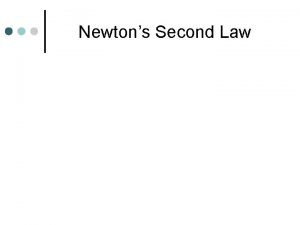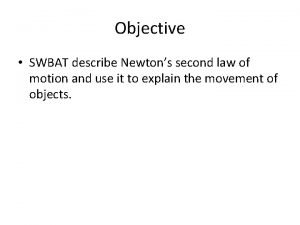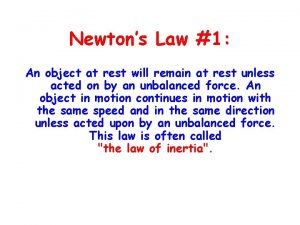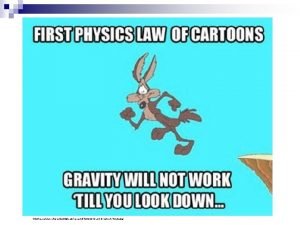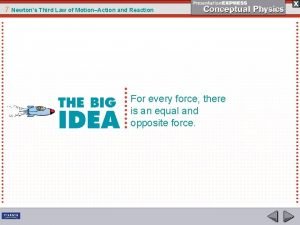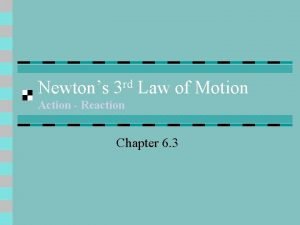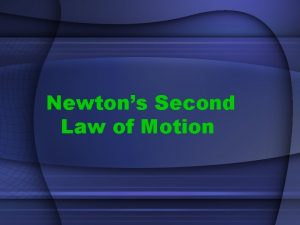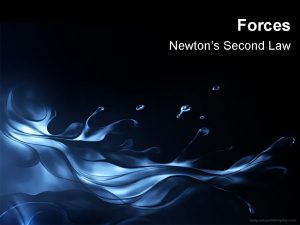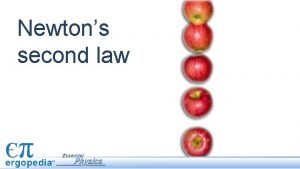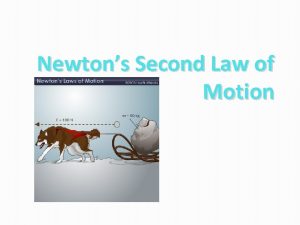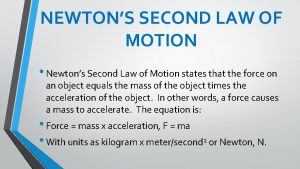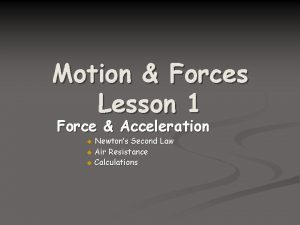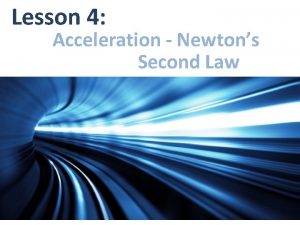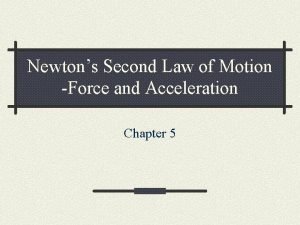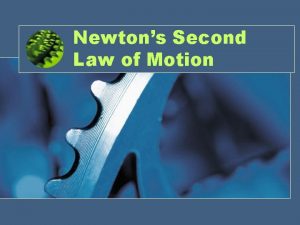Motion Forces Force Acceleration Newtons Second Law u














- Slides: 14

Motion & Forces Force & Acceleration Newton’s Second Law u Gravity u Air Resistance u Calculations u

A. Newton’s Second Law l Newton’s Second Law of Motion § The acceleration of an object is directly proportional to the net force acting on it and inversely proportional to its mass. F = ma

A. Newton’s Second Law F m F = ma F m a F: force (N) m: mass (kg) a: accel (m/s 2) 1 N = 1 kg ·m/s 2

B. Gravity l Gravity § force of attraction between any two objects in the universe § increases as. . . • mass increases • distance decreases

B. Gravity l Who experiences more gravity - the astronaut or the politician? l Which exerts more gravity the Earth or the moon? less distance more mass

B. Gravity l Weight § the force of gravity on an object W = mg W: weight (N) m: mass (kg) g: acceleration due to gravity (m/s 2) MASS WEIGHT always the same (kg) depends on gravity (N)

B. Gravity l Would you weigh more on Earth or Jupiter? § Jupiter because. . . greater mass greater gravity greater weight

B. Gravity l Accel. due to gravity (g) § In the absence of air resistance, all falling objects have the same acceleration! § On Earth: g = 9. 8 m/s 2 elephant feather Animation from “Multimedia Physics Studios. ”

C. Air Resistance l Air Resistance § a. k. a. “fluid friction” or “drag” § force that air exerts on a moving object to oppose its motion § depends on: • speed • surface area • shape • density of fluid

C. Air Resistance l Terminal Velocity § maximum velocity reached by a falling object F § reached when… air Fgrav = Fair § no net force no acceleration constant velocity Fgrav

C. Air Resistance l Terminal Velocity § increasing speed increasing air resistance until… Fair = Fgrav Animation from “Multimedia Physics Studios. ”

C. Air Resistance l Falling with air resistance § heavier objects fall faster because they accelerate to higher speeds before reaching terminal velocity Fgrav = Fair § larger Fgrav need larger Fair need higher speed Animation from “Multimedia Physics Studios. ”

D. Calculations l What force would be required to accelerate a 40 kg mass by 4 m/s 2? GIVEN: WORK: F=? m = 40 kg a = 4 m/s 2 F = ma F m a F = (40 kg)(4 m/s 2) F = 160 N

Concep. Test l Is the following statement true or false? § An astronaut has less mass on the moon since the moon exerts a weaker gravitational force. § False! Mass does not depend on gravity, weight does. The astronaut has less weight on the moon.
 Newtons second.law
Newtons second.law Newton second law
Newton second law Newton's 2nd law in soccer
Newton's 2nd law in soccer Describe newtons second law
Describe newtons second law Newtons second law
Newtons second law Newtons second law example
Newtons second law example Newtons 3 rd law of motion
Newtons 3 rd law of motion Newtons 3 rd law of motion
Newtons 3 rd law of motion Third
Third Newtons 3 rd law of motion
Newtons 3 rd law of motion Newton's 1st law meme
Newton's 1st law meme Newton's 3 laws of motion
Newton's 3 laws of motion Newtons third law of motion
Newtons third law of motion Newtons 3 rd law of motion
Newtons 3 rd law of motion Newtons 3 rd law of motion
Newtons 3 rd law of motion

